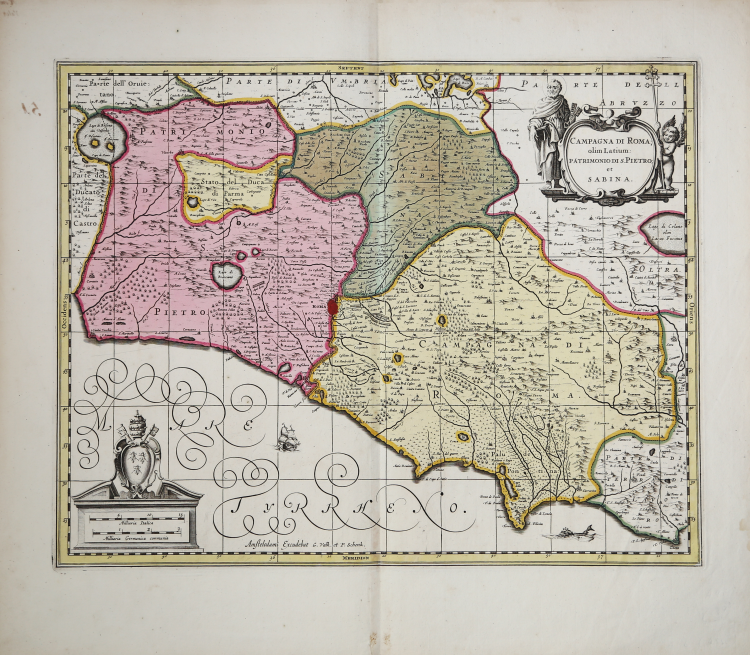



| Reference: | CO-274 |
| Author | Tipografia Valck & Schenk |
| Year: | 1690 ca. |
| Zone: | Lazio |
| Printed: | Amsterdam |
| Measures: | 515 x 400 mm |


| Reference: | CO-274 |
| Author | Tipografia Valck & Schenk |
| Year: | 1690 ca. |
| Zone: | Lazio |
| Printed: | Amsterdam |
| Measures: | 515 x 400 mm |
Rara edizione di Valck e Schenk della celebre carta del territorio di Lazio di Johannes Janssonius.
La carta - pubblicata per la prima volta nel Novus Atlas del 1645 - si basa sulle mappe di Hendrick Hondius e Johannes Blaeu, a loro volto repliche olandesi della carta di Giovanni Antonio Magini pubblicata nel 1620; vi sono solo alcune significative aggiunte negli apparati decorativi con l’inserimento di figure allegoriche, riprese dall'analoga carta di Blaeu.
Il rame passò nelle mani degli stampatori Valck e Schenk che la rimisero in commercio con la sola aggiunta del reticolo geografico e la variazione dei dati editoriali.
Si tratta dello stesso rame stampato da Joannes Janssonius nel 1645, con la sola aggiunta del reticolo geografico e la modifica dell'imprint editoriale, che diventa "Precunt Ex Officina Amstelodmani penes apud Petri Schenk, et Ger. Valk C. P.". Il reticolo grafico ha una scansione di mezzo grado. La datazione, così come la provenienza di tale carta, ossia l'inserimento di tale carta in un atlante, è molto problematica. Petrus Schenk I (1660-1718 ca) fu incisore ed editore tedesco, trasferitosi giovanissimo ad Amsterdam dove divenne allievo di Gerad Valk (1656-1726) e del quale sposò la sorella Agatha nel 1687. L'associazione tra i due risale già ai primi anni 80 del Seicento; intorno al 1690 si trovarono ad acquistare gran parte dei rami di Janssonius che furono da loro editi con piccoli ritocchi e modifiche. È molto probabile che il rame sia stato stampato ancora e commercializzato anche nel corso del Settecento a opera degli eredi Leonard Valk (1675-ante 1755) e Petrus Schenk II (1698-1775).
Acquaforte, bella coloritura coeva, in ottimo stato di conservazione.
Bibliografia
KOEMAN 1967-1985: III, 107-114 (Schenk), 136-140 (Valck).
Tipografia Valck & Schenk (attiva 1687 - 1711 circa)
|
Gerard Valk, or Gerrit Leendertsz Valck (1652-1726) together with his son Leonard, were the only significant publishers of globes in the Netherlands in the eighteenth century, enjoying an almost total monopoly in the first half of the 1700's. Initially an engraver and art dealer and having worked for map-sellers Christopher Browne and David Loggan in London between 1672 and 1679, Valk established the firm in Amsterdam in 1687. Initially, they published maps and atlases, but in 1700 the company moved the shop to the building previously occupied by map and globe-maker Jodocus Hondius. Around 1711, when he became a member of the bookseller's guild, Leonard Valk (1675-1746) came into partnership and his name started to appear alongside that of his father on the cartouches of the globes, although the earliest of these, both terrestrial and celestial, still bear the date 1700. Leonard naturally took over the business on his father's death in 1726 and following his own death in 1746 the firm was run by Maria Valk, cousin, and wife to Gerard.
Peter Schenk the Elder (1660-1711) moved to Amsterdam in 1675 and began to learn the art of mezzotint. In 1694 he bought some of the copperplate stock of the mapmaker Johannes Janssonius, which allowed him to specialize in the engraving and printing of maps and prints. He split his time between his Amsterdam shop and Leipzig and also sold a considerable volume of materials to London. Peter Schenk the Elder had three sons. Peter the Younger carried on his father’s business in Leipzig while the other two, Leonard and Jan, worked in Amsterdam. Leonard engraved several maps and also carried on his father’s relationship with engraving plates for the Amsterdam edition of the Histoire de l'Académie Royale des Sciences.
|
Tipografia Valck & Schenk (attiva 1687 - 1711 circa)
|
Gerard Valk, or Gerrit Leendertsz Valck (1652-1726) together with his son Leonard, were the only significant publishers of globes in the Netherlands in the eighteenth century, enjoying an almost total monopoly in the first half of the 1700's. Initially an engraver and art dealer and having worked for map-sellers Christopher Browne and David Loggan in London between 1672 and 1679, Valk established the firm in Amsterdam in 1687. Initially, they published maps and atlases, but in 1700 the company moved the shop to the building previously occupied by map and globe-maker Jodocus Hondius. Around 1711, when he became a member of the bookseller's guild, Leonard Valk (1675-1746) came into partnership and his name started to appear alongside that of his father on the cartouches of the globes, although the earliest of these, both terrestrial and celestial, still bear the date 1700. Leonard naturally took over the business on his father's death in 1726 and following his own death in 1746 the firm was run by Maria Valk, cousin, and wife to Gerard.
Peter Schenk the Elder (1660-1711) moved to Amsterdam in 1675 and began to learn the art of mezzotint. In 1694 he bought some of the copperplate stock of the mapmaker Johannes Janssonius, which allowed him to specialize in the engraving and printing of maps and prints. He split his time between his Amsterdam shop and Leipzig and also sold a considerable volume of materials to London. Peter Schenk the Elder had three sons. Peter the Younger carried on his father’s business in Leipzig while the other two, Leonard and Jan, worked in Amsterdam. Leonard engraved several maps and also carried on his father’s relationship with engraving plates for the Amsterdam edition of the Histoire de l'Académie Royale des Sciences.
|